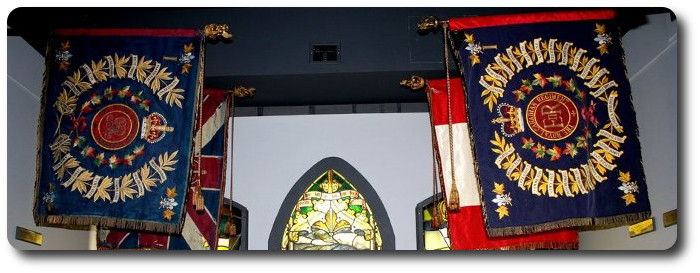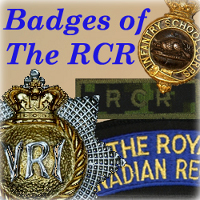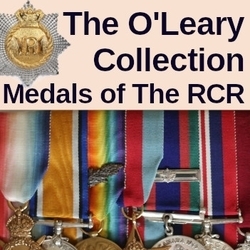
Researching The Royal Canadian Regiment
Pachino to Regalbuto, Thirty Years Later
Colonel Strome Galloway
Pro Patria #17; August 1973
In May it was my good fortune to stand at Maucini, a farmstead in the Pachino peninsula, and tell a group of some 80 NATO officers how "A" and "B" Companies of The Royal Canadian Regiment captured the airfield and a coastal battery in the blistering hot sun of July 10, 1943.
It is a strange feeling to see again after thirty years, the peaceful vineyards and the blue off-shore waters through which we moved with both fear and determination on The Regiment's first day of battle in the Second World War.
Only one RCR officer and half-a-dozen men were wounded that day. Only two RCR men were killed, Ptes Hefford and Thorn. It was a pushover! My Company captured the battery commander and all the men, 35 of them, at a coastal battery. Sgt Jean Bougard rounded them up almost single-handed. The only blood spilled by our side was when I fell over the barbed wire and put a three-inch gash in my thigh! As for "A" Company, led by Capt Slim Liddell, it swept across the airfield like a scythe, garnering over 400 Italian prisoners as a result. Pte Joe Grigas got the DCM and Pte Jack Gardner got the MM when they knocked out a stubborn Italian machine-gun post that wounded a couple of chaps, including Pte Je Gozdz. I saw "Ye" coming back as a walking-wounded, a shell dressing on his right shoulder where a MG round had penetrated. He got back to the battalion afterwards, but was killed up Ortona-way the following December.
When "A" and "B" Companies landed they were known as "Stromeforce", as I was to coordinate their activities until BHQ got ashore. It was at Maucini where Slim Liddell peeled off to capture the airfield and I went on to grab the coastal battery. The place looks a lot better now than it did then. Maucini is well-painted, the vineyards are irrigated and large areas are covered with plastic sheets to force growth by concentrating the warmth of the sun on the vines. In the brilliant sunshine the plastic covered areas look like dozens of little square ponds. A few of the dusty trails remain, but a large tarvia road cuts across our old beachhead now.
One of the incidents which I told the NATO chaps about, was when L/Sgt Sandy Leith went off to a previously selected map reference to contact the 7th Argyll and Sutherland Highlanders, of 5lst Highland Division. The contact point had been laid on when The RCR was up in Scotland and the Argyll battalion was in North Africa, a couple of thousand miles apart. Good staff planning? Good map reading, too, on Sandy Leith's part! Leith went on as far as Assoro, where he was wounded while a "B" Company fighting patrol was shooting it out with Some members of 15th Panzer Grenadiers.
Sicily looks quite a lot different today than it did thirty years ago. It is well-irrigated for one thing, and therefore much greener. Of course, I was there in May instead of July, So that would help. The towns that we knocked down with aerial bombing and artillery are naturally rebuilt, So they are different too But the people seem to live just as primitively now as then, except more Fiats are to be seen than mules! When we fought in Sicily most of the country people were peasants, labouring for land barons. In about 1955 the Italian Government took much of the land from the big landowners and divided it up among the peasants, Since becoming independent farmers these people have grown somewhat more prosperous, Their homes don't look much better, but some farm machinery is to be seen as well as a lot of motor cars.
At Nissoria, Agira and Regalbuto things don't look much different except that when I was giving a talk to our study group on how we attacked Regalbuto, I said that strangely enough I did not remember the big lake on the north side of Highway 121, which was our divisional axis. An Italian Major-General who was with the group said I couldn't have, as the lake was artificial and had only been there since about 1960! The Canadian cemetery is on a hill between Agira and Regalbuto. Last January the Cross of Sacrifice was struck by lightning and is still lying shattered on the ground. This was a nasty surprise, especially for me, when our party arrived to lay a wreath. The NATO general and I laid the wreath, a huge circle of evergreen about four feet across, We stood at attention while the uniformed NATO group saluted during the one minute's silence. Nearly half the group were Germans, the others British, Belgian and Dutch, Only a few of them had been old enough to serve in the war. Indeed, most of them had been mere children. It gives one a strange feeling to be almost alone among another generation. Our lecturers were all veterans of the Sicilian campaign, of course, There were three Germans; Colonel von Bonin, who had been Chief of Staff of the Hermann Goering Division, which The RCR first met at Valguarnera, was the most famous of the lot, He had been on Rommel's staff in Africa, then had been employed in the Fuehrerbunker in East Prussia, where he was serving when we invaded Sicily, Several days later he was sent to Sicily to become the Hermann Goering Division commander's right-hand man and put some backbone in the defences. After Sicily he became Chief of Staff to Panzerleader Heinz Guderian on the Russian front and near the end of the war was put into Dachau by Hitler's personal order because he had planned a retreat when Hitler had ordered "last man, last round" stand.
The other two Germans were Lt-Col Rebholz, who commanded the HG Division recce battalion and Lt-Col von Benda, an Artillery officer. Rebholz told us that on the night of July 9th he had gone swimming at Pachino where he had one of his recce vehicles stationed with the Italian coastal division. On his way back to his headquarters at Caltagirone the Allied air attacks hit a number of places and he had a hard time getting through the debris. He withdrew his coastal recce vehicles to Caltagirone just before first light on July 10th. For the next five days the HG Division were concerned with the American landings at Gela, where they counter-attacked unsuccessfully, It was not until later that he had any contact with Canadian recce elements. He was among the last Germans evacuated across the Straits of Messina in mid-August. After our Sicily tour my wife and I spent several weeks in Germany during which time we were guests of Lt-Col Rebholz and his wife at their home on the Rhine.
Von Benda was the officer directing defensive fire against the Catenanuova bridgehead which the West Nova Scotia Regiment (then commanded by Lt-Col, later Maj-Gen, Bogert) made at the end of July for the British 78th Division to pass through to capture Centuripe on our right flank.
The most moving experience of my Sicilian tour was when I entered the Canadian cemetery, wondering which would be first familiar name to meet my eyes. I felt quite a chill up my spine when I saw the name Giggey, and right behind him in the next row, Boyce. Both of them I could see in Memory's eye with no difficulty. It seemed only yesterday since I had talked to each of them. next I saw "Squeak" Earnshaw's grave, then Ralph Crowe's and finally Norton 28's. There was no time to walk around among the almost 500 graves, as our group had to go on the German cemetery near Catania before dark, and I was scheduled to give a 20 minute talk on the fighting at Regalbuto, which we could see a few kilometers down the road. I felt a special pang when I saw Norton's name, as I could still hear him saying, "I'm done for, Sir." That was at Assoro, when Pte Bancroft tried to bandage a gaping belly wound which a sniper had inflicted as Norton gave covering fire to Lt Harry Keane and me, as we ran back down a slope with bullets whizzing about our ears. Why, I wondered, did that sniper decide to take aim on Norton and not either on Keane or me? Norton's brother, also known by the last two figures of his regimental number because their initials were the same, J.E., was killed at Ortona five months later, almost to the day. By strange coincidence I also spoke to him less than half an hour before he was dead. The Norton brothers were both splendid NCO's.
There is much more to tell of my return visit to Sicily, because I spent ten days there. It was a wonderful experience to go back as an official spokesman, all expenses paid. How else could I have ever done it? I hope some of the things I have written here will be of interest to those of The Regiment who took part in "Sicily's 38 Days". Sometimes it seems just like yesterday. Sometimes like a dream that is almost forgotten. But to go back and stand in the same places, to walk up the slopes of the same hills, to see the same buildings like Maucini, the water tower at the Pachino airfield and the last objective, Tower Hill at Regalbuto, is an almost unbelievable adventure, and So much easier and safer than it was in 1943!


